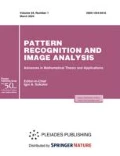Abstract
Theoretical descriptions of nuclear reactions such as fission and quasi-fission make it possible to represent the evolution of a nuclear system as a trajectory in a multidimensional deformation space. We propose a strategy for revealing images of such trajectories in the space of experimentally observed variables at a specified reliability level. The approach proposed is based on mathematical methods of morphological analysis of images and makes possible a detailed analysis of successive stages of nuclear reactions with a duration of about 10−20 s.
Similar content being viewed by others
References
The Nuclear Fission Process, Ed. by C. Wagemans (CRC Press, 1991).
Yu. V. Pyatkov, et al., Nucl. Instrum. Methods A 488, 381 (2002).
U. Quade, et al., Nucl. Phys. A 487(1) (1988).
M. N. Tao, et al., Nucl. Instrum. Methods A 313, 227 (1992).
T. Ohtsuki, et. al., Phys Rev. Lett. 66, 17 (1991).
A. A. Alexandrov, et. al., Nucl. Instrum. Methods A 303, 323 (1991).
W. H. Trzaska, et. al., cP 392. AIP Press, (1997), p. 1059.
W. H. Trzaska, et. al., in Proc. Symp. on Nuclear Clusters. Aug. 5–9 2002 (Rauischholzhausen, 2002), p. 237.
Yu. P. Pytyev, “Morphological Image Analysis,” Pattern Recogn. Images Analysis 3(1), 19–28 (1993).
O. V. Falomkina, et al., “Heavy Ion Physics,” FLNR JINR Sci. Rep. 2001–2002 (Dubna 2003), p. 149.
V. V. Pashkevich, Nucl. Phys. A 169, 275 (1971).
U. Brosa, et. al., Phys. Rep. 197, 167 (1990).
J. F. Berger, et al., Nucl. Phys. A 428, 230 (1984).
Yu. V. Pyatkov, et al., Nucl. Phys. A 624, 140 (1997).
Yu. V. Pyatkov, et al., Phys. Atomic Nuclei 67, 1726 (2004).
D. J. Hinde, et al., Nucl. Phys. A 452, 550 (1986).
O. V. Falomkina, et al., “Heavy Ion Physics,” FLNR JINR Sci. Rep. 2003–2004 (Dubna, 2006), p. 158–159.
Handbook of Statistics, Ed. by C. R. Rao (North Holland/Elsevier Sci. Publ., New York, Amsterdam), Vols. 1–18.
Author information
Authors and Affiliations
Corresponding author
Additional information
Yurii Petrovich Pyt’ev. Born in 1935. Graduated from the Faculty of Physics at Moscow State University (MSU) in 1959. Received Ph.D. in theoretical physics from MSU in 1963 and the Doctor of Science degree in 1976. Head of the Chair of Computer Methods at the Faculty of Physics of MSU since 1995. Scientific interests: fuzzy and uncertain fuzzy mathematics, theory of possibilities, mathematical modeling, image processing, signal and scene processing, and pattern recognition. Author of more than 400 papers.
Dmitrii Vladimirovich Kamanin. Born in 1966. Graduated from the Faculty of Physics at Moscow State University (MSU) in 1989. Received Ph.D. in physics of atomic nuclei and elementary particles from the Technical University of Dresden in 1999. Senior Researcher and Deputy Scientific Secretary-in-Chief of the Joint Institute for Nuclear Research. Scientific interests: heavy-particle decay, spontaneous fission, neutron-induced fission. Author of more than 120 papers.
Trzaska Wladyslaw Henryk. Born in 1955. Graduated from the Department of Physics at the University of Warsaw. Received Ph.D. in 1989 from the Department of Physics, University of Jyvaskyla, Finland, where he worked as a Senior Researcher. Scientific interests: nuclear physics, relativistic heavy ion collisions, and astroparticle physics. Author of about 250 papers.
Barend M. Herbst. Born in 1953. Received Ph.D. in Applied Mathematics from the University of the Free State. Currently, Professor in Applied Mathematics, University of Stellenbosch, South Africa. Scientific interests include machine learning and computer vision.
Rights and permissions
About this article
Cite this article
Pyatkov, Y.V., Kamanin, D.V., Falomkina, O.V. et al. Estimating the reliability of revealing the fine structure in mass-kinetic energy distributions of nuclear reaction products. Pattern Recognit. Image Anal. 21, 82–87 (2011). https://doi.org/10.1134/S1054661811010111
Received:
Published:
Issue Date:
DOI: https://doi.org/10.1134/S1054661811010111



